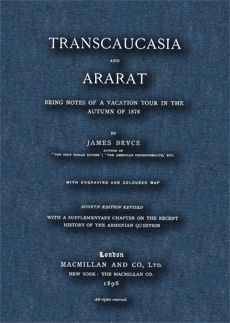| Éditeur : Macmillan Co | Date & Lieu : 1896-01-01, New York |
| Préface : | Pages : 528 |
| Traduction : | ISBN : |
| Langue : Anglais | Format : 135x200 mm |
| Code FIKP : Lp. Ang. Pri. 286 | Thème : Mémoire |
|
Présentation
|
Table des Matières | Introduction | Identité | ||
 Transcaucasias and Ararat The Volga and the steppe of southern Russia North-western Russia, although it is now pretty easy of access from Western Europe, and contains two such wonderfully striking cities as Moscow and St. Petersburg, is very little visited by travellers. South-eastern Russia is hardly visited at all. Nijni Novgorod, whose great fair draws some few sight¬seers as well as men of business from Germany and the farther west, seems to be the limit of the tourist, and beyond it, all the way to Tiflis or Constantinople, one does not see a single stranger travelling for pleasure, and discovers from the attentions which the western visitor receives, how rare such a visitor is. I need, therefore, make no apology for giving some short account of the Lower Volga, and the great steppe of Southern Russia, before getting to the Caucasus and Armenia, for all four is likely to be equally unfamiliar to English readers. As this does not apply to the gathering which has made Nijni famous, there is no occasion to describe it here, especially as a full account of the fair and its … | |||||
| Table des Matières | ||||
| ||||